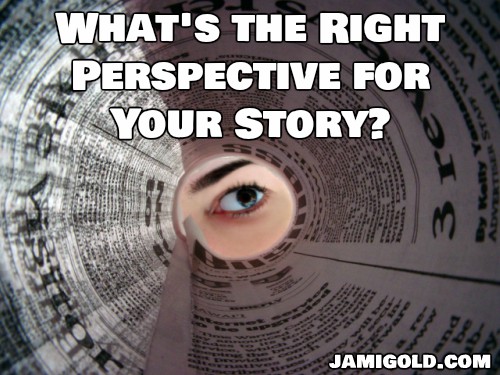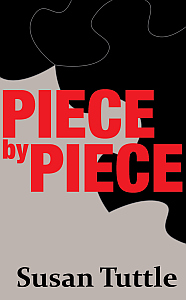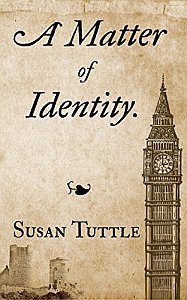Understanding Our POV Choices — Guest: Susan Tuttle

When we first start writing, we might imitate the styles we’ve seen in books we’ve read. However, once we learn more about writing craft, we tend to explore our voice and what makes our storytelling unique.
One aspect of writing that we often emulate without thinking is point of view (POV), which we’ve talked about here before. The POV we use for our writing is likely one we’ve seen in other stories, so it’s what feels natural or normal.
But that usual approach isn’t necessarily the best choice for the story we’re trying to tell. Our options for POV go beyond the obvious, and finding the right perspective for our story might mean ignoring the default technique we’re used to.
How can we know which choice is right for us and our story? Susan Tuttle is here to share her insights into POV, with a different way of looking at our options and the pros and cons of each one. So if you’ve ever struggled with POV before (or if you’ve never thought beyond the default), maybe her interpretations and explanations will trigger new understanding.
Please welcome Susan Tuttle! *smile*
*****
Demystifying POV
by Susan Tuttle
Few things can pull readers out of a story more than an awkward Point of View or a POV switch. They may not know what to call it, but they do know something is wrong. And that’s not anything any writer ever wants to happen.
POV is arguably the easiest concept to understand, but the hardest to put into practice. That’s because there are no standard terms for POV.
When I began teaching fiction writing, I researched how other writers described POV, and got totally confused by the varying terminology. I took gobs of notes, then distilled them down into 7 main types that made logical sense to me:
- three Straight POVs,
- three Emotional Omniscient POVs, and,
- one Classic Omniscient POV.
Understanding these 7 main types of Point of View and when to use each can help writers of both fiction and creative nonfiction avoid the dreaded POV switch.
3 Straight POVs
Option #1: First Person Straight POV
A single character tells the entire story, using “I” and “we,” in either present or past tense. Only what this one character sees, hears, thinks, feels, and experiences can be narrated in the story. It feels very close to readers, as though the character is speaking directly to them.
The main drawbacks are the character must be “on stage” for the entire story, and deep, disturbing emotions may be too strong for this POV. Also, the success of this POV rests entirely on the consistence of the voice.
Ex: I walk into the crowded room with my head held high and walk toward the podium on trembling legs. My heart is pounding. If anyone thought I wouldn’t show up to accept this award, they were sadly mistaken.
Option #2: Second Person Straight POV
This form uses “you” in place of the “I.” The narrating character is unseen and unknown. This form puts the reader into the central character’s place.
The drawback is that it is very hard to create the necessary reader/character bond, especially if the personality of the character is diametrically opposed to that of the reader. The actions and motivations become unbelievable to the reader.
This is a very distancing POV. Workable for the right short story, but hard to maintain for a full length novel.
Ex: You walk into the crowded room with your head held high, and you walk toward the podium. Your legs are trembling, your heart pounding. But you are determined to accept this award, no matter what anyone else thinks.
Option #3: Straight Third Person POV
In this form, a narrator is telling the story as if “he” were one of the characters—the protagonist, one of the sidekicks, or even the antagonist. It can be in present or past tense, though past is easiest to write and read.
It is a comfortable distance for readers when it comes to deep or disturbing emotions. Because the narrator is pretending to be the narrating character, he can delve very deeply into the character’s thoughts, emotions and motivations. This POV can create an almost unbreakable bond between readers and the POV character.
The main drawback is that the narrator is limited to just this one character to tell the story.
Ex: She walked into the crowded room with her head held high, even though her legs trembled and her heart pounded. She knew many of those assembled didn’t want her to receive this award, but she’d be damned if she let them intimidate her into running away like a coward.
3 Emotional Omniscient POVs
I call these next three POV types emotional because that is the base of them: the emotions of the characters. “Omniscient” means “all seeing”; applied to fiction, it means the narrator can switch from one character to another.
With a couple of variations, most Emotional Omniscient POVs are rendered in Third Person.
Option #1: Shifting Third Person POV
Shifting Thirds allows the narrator to move, or “shift”, in and out of characters’ heads at will, sometimes in the same paragraph. There are no line breaks or other devices used to alert readers to the shifts.
Though out of favor in most genres these days, it is still occasionally used in romance, sci-fi, and fantasy.
The main drawback is that if the writer is not exceptionally skilled at shifting, readers can become confused as to whose mind they are in. It also takes much longer to create the reader/character bond, because the narrator is not in anyone’s head for very long.
Ex: Though her heart quivered and her body trembled, Meleia stood still, staring at Solon, refusing to let him see how frightened she was. Solon liked her spunk; he smiled in appreciation of her courage, foolish though he knew it was. Meleia clenched her hands and lifted her chin, determined to foil whatever plans he had.
Option #2: Close Third Person POV
Close Thirds also allows narrators to switch characters, only not as often as in Shifting Thirds. Often two-thirds of a scene, an entire scene, or a significant portion of a chapter is rendered from one character’s viewpoint before the narrator switches to another character.
This helps to quickly build the sympathetic bond between readers and character, because they spend an appreciable amount of time with the character. And having more than one POV character will draw in more readers, because they can bond with the one that most appeals to them.
Every POV option has pros and cons--which is the right choice for our story? Click To TweetThe main drawback in Close Thirds is not alerting readers clearly enough that a switch has taken place. In that case, readers can be confused as to who is telling this portion of the story.
Another danger is having too many POV characters, which can also confuse readers. It is critical to choose only those 2, 3, or 4 characters who can best tell each portion, and keep moving the story forward.
When writing in Close Thirds POV, always use a line break when switching character viewpoints, and always identify the new character clearly in the first two lines of the new portion. When narrating each character’s portion of the story, Straight Thirds POV rules apply; you can only render what the current POV character thinks, see, feels, hears, and experiences.
Ex: Meleia could see thoughts race behind Solon’s eyes, though she had no idea what they were. Did he understand who she was, what she was here for? Meleia stood as still as she could, despite her thudding heart and quivering body, and stared at him. She would not let him see how frightened she was. And no matter what, she would foil whatever plans he had.
* * *
Menja Solon stared at the young girl who stood so defiantly in the dank, dim cell. She didn’t show enough fear, not by half. Why? he wondered. He might like her spunk and her courage, but he needed fear. Yes, fear and what it brought him, that was what he was after.
Option #3: Alternating Thirds POV
The last of the Emotional Omniscient POV types is Alternating Thirds POV. In this form, an entire chapter or section is narrated from one character’s POV.
The next chapter or section is narrated from a second character’s POV. Then the third chapter or section goes back to the first character. You can also alternate between up to 4 characters—any more can be confusing to readers.
Be sure to identify the narrating character at the beginning of each chapter or section. Do not rely on chapter headings to do the identification for you (ex: Chapter 1, Amy; Chapter 2, John).
Close to 90% of readers do not read chapter headings. Use them if you want, but also identify the new narrating character within the first two sentences, every time.
Emotional Omniscient Variations:
In both Close Thirds and Alternating Thirds, one character can narrate from Straight First Person for that section, while all the other characters narrate from Straight Third Person for their sections.
Do not use more than one First Person narration; it is extremely difficult to identify first person narrators by name (how many of us think, “I, Susan, will go to the store later”?) without using contrived devices, and even more difficult to make the various voices so unique and different they are immediately recognizable to readers. Stick to one First Person combined with the rest in Third Person.
Classic Omniscient POV
The final main POV type is what I call Classic Omniscient POV. It is the POV most 19th and early 20th Century novels and stories were written in. Classic Omniscient POV does not allow the writer to access any character’s thoughts, feelings, or emotions.
The Classic Omniscient narrator is like a camera with a voice recorder attached, perched high above the action. It records only what it can see and hear, nothing else. No internal thoughts. No memories. No emotions.
The major challenge when removing the emotion from the POV is building interest for readers. The characters still have to be real and compelling. You still have to create the character/reader bond.
The secret to a successful Classic Omniscient story is bringing emotions to the fore without accessing them directly. It’s a case of “not what you say, but how you say it.” You need to choose the details of what can be seen and heard in such a way that it conveys the impression of emotion, even though they do not directly access any thoughts, feelings or emotions.
This POV creates the most distance between readers and characters, because the emotion is only implied. But it gives greater latitude, because the “camera” can tell readers things the characters can’t know, see, or even hear.
Ex: Joe and Andrew continued to plan the bank robbery. They didn’t know that the police had pulled into the alley and were even now surrounding the building, in which they had planted a listening device.
Full Classic Omniscient POV Example:
Kelly walked into the room with her head held high. She didn’t look at anyone, but kept her gaze on the podium as she walked. People at the tables stopped eating and stared at her. She threaded her way through the tables and approached the steps to the stage, leaving behind her a growing buzz of conversation.
Janet watched Kelly walk across the room. Her brows drew into a frown and her hands curled into fists. She leaned toward Brad, sitting next to her, and spoke while tracking Kelly’s progress through the huge, crowded room.
“I can’t believe she showed up, after what she did. And I can’t believe they’re giving her an award. I hope she’s booed off the stage.”
Brad nodded and gave Janet a wink. But his gaze did not leave the tall, slender figure that approached the steps to the stage.
It’s worth taking the time to periodically write a few scenes using Classic Omniscient POV just for the experience of choosing exactly the right details to imply emotion. It’s a skill that enhances your ability to render both characters and settings when writing in any other of the POV types.
How to Choose the Correct POV
Always ask yourself:
- Whose story is the part of the scene/chapter/section?
- Who can best tell what happens here?
- Is this really a straight POV story, or will an added POV enhance it?
Sometimes the character we instinctively choose is not the best one to narrate the tale, or even that portion of it. And sometimes another character’s viewpoint can add a twist, stumbling block, or unique perspective we hadn’t thought of.
Not until we experiment with differing POVs and ask, “Whose story is it?” will we know the correct POV to choose.
4 Tips to Improve Your POV Technique
Always keep in mind the Four Techniques to use for every POV switch (except Shifting Thirds):
- Know which part of the story belongs to which character.
- Make each POV character’s voice different and unique.
- Identify the POV character clearly within the first two sentences of his/her section.
- Insert a line break whenever you switch to a new POV character.
I hope this helps you better understand this very slippery concept. Once you become more aware of the types of POV and how they serve each story, you’ll be able to identify which will work best for each of your stories, and those places where an unscheduled switch takes place.
*****
 Susan Tuttle is an editor, writing instructor, and the award-winning author of 5 suspense novels, one short-story collection, a book of poetry, and the 6-volume workbook series titled Write It Right: Exercises to Unlock the Writer in Everyone. She is a member of SLO NightWriters, the Central Coast Chapter of Sisters in Crime (SinC), SinC National, and the Public Service Writers Association (PSWA).
Susan Tuttle is an editor, writing instructor, and the award-winning author of 5 suspense novels, one short-story collection, a book of poetry, and the 6-volume workbook series titled Write It Right: Exercises to Unlock the Writer in Everyone. She is a member of SLO NightWriters, the Central Coast Chapter of Sisters in Crime (SinC), SinC National, and the Public Service Writers Association (PSWA).
Through her publishing company (WriterWithin Publications) she offers mentoring, editing, and layout services. She lives on the Central Coast of California where she is hard at work on the first volume of a new series featuring Skylark, a female detective with paranormal abilities, due out in early 2018. Under the name Susan Grace O’Neill, she writes spiritual meditations and Bible studies, her Journey With Jesus series.
Find her on Facebook, Twitter (@stuttlewriter), Goodreads, LinkedIn, and her website, which has a weekly writing prompt every Wednesday.
*****
 Thank you, Jami, for letting me “sound off” on Point of View. I truly enjoyed the opportunity, and for your readers I have a special offer:
Thank you, Jami, for letting me “sound off” on Point of View. I truly enjoyed the opportunity, and for your readers I have a special offer:
I’ve priced two of my books on Kindle for only 99 cents each!
The first is written in Close Thirds Omniscient POV: Piece By Piece about a woman with total amnesia who begins to have flashes of memories—of a murder she may have committed.
The other, an historical suspense novel,  is written in Straight First Person: A Matter of Identity, about a woman stranded in 1866 London by her father’s suicide, who runs afoul of some very wealthy, unscrupulous men.
is written in Straight First Person: A Matter of Identity, about a woman stranded in 1866 London by her father’s suicide, who runs afoul of some very wealthy, unscrupulous men.
Choose either, or choose both of them!
Go to www.WriterWithinPubs.com and click on the book covers—they’ll take you directly to Amazon. While you’re there, also check out my series of workbooks for writers, Write It Right, with exercises for improving our craft, including working with Point of View.
*****
Thank you, Susan! Even though we often think of only the “big three” perspectives (first, second, and third person) when discussing POV, you’re right that we can look deeper at the variations of those (especially with third person) to find exactly the right approach for our voice and story. And no matter how much we’ve studied POV before, hearing the lessons from another perspective can often deepen our understanding. So I’m glad you were able to join us today.
(Note: If you’ve heard of head-hopping, that’s a major risk of what Susan calls Shifting Third Person. In other words, another potential drawback of choosing that option is earning the ire of other writers for breaking “the rules,” especially if we use that technique poorly. *smile*)
As a romance author, I use Close Third Person POV. As Susan so insightfully pointed out, that option is often used when we want readers to emotionally bond with more than one character, such as both the hero and heroine (or whatever relationship combination we’re using in our story).
Romance stories are built on emotions and readers rooting for the characters to reach their happy ending. A Close Third Person POV works well for those goals.
Similarly, in whatever genre we write, we can think of the various goals we want to accomplish with our storytelling style and determine which POV styles to consider. Some might fit better with stories where many characters share the focus, others will support a just-the-facts focus on the plot, and still others will allow for stronger bonds between readers and characters for emotional tales.
At the same time, thinking about the “whose story is it?” question Susan mentioned above will help us know whose perspective to use once we decide on our POV style. Together, these considerations can lead us to perfect way to tell our story. *smile*
Do you actively think about which POV style to use, or do you go with the default? Does this post help fill in what pros or cons we should consider when making our choice? Do you find the various POV options confusing? Do the explanations here help your understanding? Do you have any questions for Susan?
Pin It
How awesome to see you here Susan! Fantastic post. You’ve always be a big help to new writers trying to understand POV. Your books are fantastic. (Susan and I are friends IRL and we’re both members of the SLO Nightwriters and Central Coast Sisters in Crime. Thanks for hosting Susan, Jami! )
Thanks for the kind words, Anne. I really hope readers can better understand POV now, it’s such a hard concept to both understand and put into practice. I really appreciate your feedback. It means a lot coming from an expert like you!
I learned some things. I write in first person POV because I thought that would encourage me to write about emotions and prevent an academic style. Your description of omniscient points of view was illuminating.
June, so glad my post was able to help. POV is such a hard concept to wrap one’s mind around… I did a lot of research and soul searching to make it make sense to me… Thanks for the feedback!
Wow, I never knew that most readers don’t look at POV character headings…
(E.g.
Chapter One
Gabriel
)
What I particularly enjoy as a reader, are those romances with an alternating first person POV. For instance, Chapter One is told by Percy, Chapter Two by Jim, and Chap Three is back to Percy, etc. Though a character can have more than one chapter in a row. Some stories tell you which character’s turn it is by having their name right under the chapter heading, which I find helpful, since first person narrators don’t usually mention their own name. Some other stories don’t use such headings, but it’s usually easy to discover whose POV it is.
I also love it when you’ve only had POVs from the two main characters, and then you suddenly get a scene from the villain’s or a secondary character’s POV, because you do get an interesting new perspective on the story.
Hi Sieran, I love stories written in multiple first person, too, but the main problem I find is that the voices aren’t different enough to tell who is who. It can be helpful to list the names under the chapter headings, but be aware that 85-90% of readers don’t read chapter headings. I find using first person with one character and then third with the rest works best for me in my writing. And yes, my villains always have their “say” in my stories. i love their perspectives!
Thanks. I usually write first or third past.
Clare, I hope my post was helpful for you. It’s nice to know the options you have available, in case you want to experiment with a different POV for a particular story.